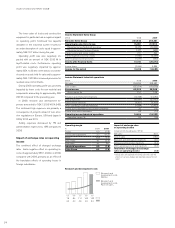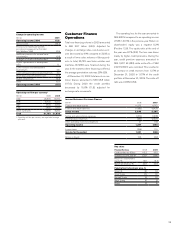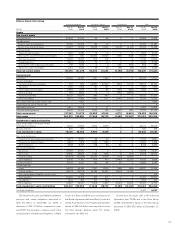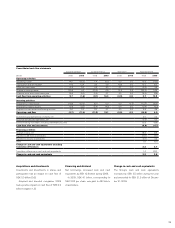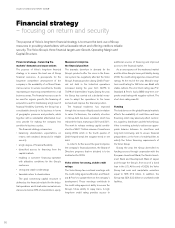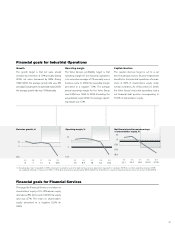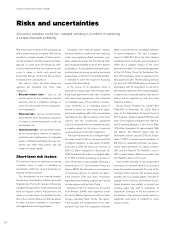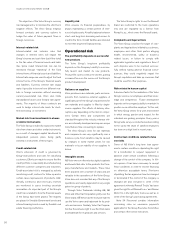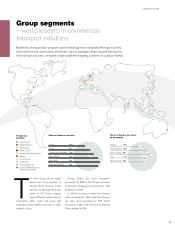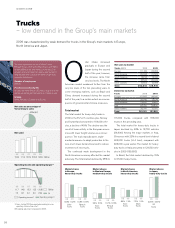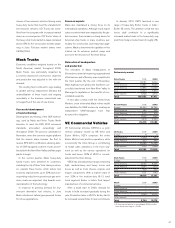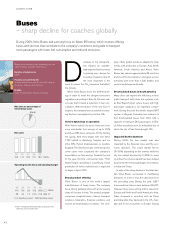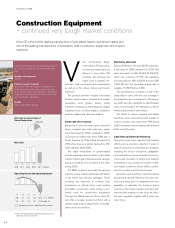Volvo 2009 Annual Report Download - page 38
Download and view the complete annual report
Please find page 38 of the 2009 Volvo annual report below. You can navigate through the pages in the report by either clicking on the pages listed below, or by using the keyword search tool below to find specific information within the annual report.
BOARD OF DIRECTORS’ REPORT 2009
Risks and uncertainties
All business operations involve risk – managed risk-taking is a condition of maintaining
a sustained favorable protability.
Risk may be due to events in the world and can
affect a given industry or market. Risk can be
specic to a single company. At Volvo work is
carried out daily to identify, measure and man-
age risk – in some cases the Group can inu-
ence the likelihood that a risk-related event will
occur. In cases in which such events are
beyond the Group’s control, the Group strives
to minimize the consequences.
The risks to which the Volvo Group are
exposed are classied into three main
categories:
External-related risks• – such as the
cyclical nature of the commercial vehicles
business, intense competition, changes in
prices for commercial vehicles and govern-
ment regulations.
Financial risks • – such as currency fluctua-
tions, interest levels fluctuations, valuations
of shares or similar instruments, credit risk
and liquidity risk.
Operational risks • – such as market recep-
tion of new products, reliance on suppliers,
protection and maintenance of intangible
assets, complaints and legal actions by cus-
tomers and other third parties and risk
related to human capital.
Short-term risk factors
The downturn has led to cautiousness among
customers when it comes to deciding on
investments, which has caused a decrease in
demand for Volvo products.
The development on the nancial markets
has led to an intensication of Volvo’s work with
nancial risks. The credit risks are continuously
managed through active credit monitoring and
there are regular controls that provisions are
made on incurred losses for doubtful receiva-
bles in the customer nance portfolio as well as
for other accounts receivable, in accordance
with applicable accounting principles.
Instability in the nancial markets impacts
the accessibility to credits and loan nancing,
which may negatively affect customers, sup-
pliers, dealers as well as the Volvo Group. Sup-
pliers’ nancial instability could result in delivery
disturbances. A sound balance between short-
and long-term borrowing, as well as borrowing
preparedness in the form of overdraft facilities,
is intended to meet the long-term nancing
needs of the Volvo Group.
In the course of its operations, Volvo is
exposed to residual value risks through oper-
ating lease agreements and sales combined
with repurchase agreements. The estimated
net realizable value of the products is continu-
ously monitored on an individual basis. A
decline in prices for used trucks and equip-
ment may negatively affect the consolidated
operating income. High inventories in the truck
industry and the construction equipment
industry combined with low demand may have
a negative impact on the prices of new and
used trucks and construction equipment.
The reported amounts for contingent liabili-
ties reect a part of Volvo’s risk exposure.Total
contingent liabilities on December 31,2009,
amounted to SEK 9.6 billion, an increase of
SEK 0.2 billion compared to December 31,
2008. Included in the total is a contingent liabil-
ity of SEK 0.5 billion pertaining to a claim on
Volvo Powertrain to pay penalties following a
demand by the U.S. Environmental Protection
Agency (EPA). The demand is a consequence
of dissenting opinions on whether an agree-
ment between EPA and Volvo Powertrain
regarding lower emitting engines also should
include engines sold by Volvo Penta.
Members of the U.S. trade union, the United
Auto Workers (UAW), have approved a new
40-month Master Agreement with the Volvo
Group’s subsidiary Mack Trucks. The agree-
ment includes the establishment of an inde-
pendent trust that will completely eliminate
Mack’s commitments for providing healthcare
to retired employees. This had a negative
impact of SEK 877 M on the Volvo Group’s
operating income during the second quarter of
2009 and a negative impact of the same
amount on net debt. The trust must be approved
by the U.S. District Court for the Eastern Dis-
trict of Pennsylvania, which is expected in the
third quarter of 2010. The Volvo Group will fund
the trust with USD 525 M, paid over 5 years. In
accordance with the description in note 24 to
the nancial statements, the funding obligation
is reported as a nancial liability while amorti-
zations will be reported as cash flow from
nancing activities.
Nissan Diesel Thailand Co. Limited (the
“Plaintiff”) on November 30, 2009, led a
claim at the Pathumthani Provincial Court of
First Instance, Thailand, against AB Volvo and
three of its employees (together the “Defend-
ants”), claiming damages in the sum of Baht
10.5 billion (equivalent to approximately SEK
2.2 billion). The Plaintiff claims that the
Defendants’ actions caused UD Trucks Corpo-
ration (“UDT”), a wholly-owned subsidiary of
AB Volvo, to unlawfully terminate two agree-
ments dated December 27, 2002, between
UDT and the Plaintiff. The Plaintiff is one of
UDT’s private dealers. AB Volvo considers that
the Plaintiff’s claim is of no merit.
Volvo veries annually, or more frequently if
necessary, the goodwill value of its business
areas for possible impairment. The size of the
overvalue differs between the business areas
and they are, to a varying degree, sensitive to
changes in the business environment. A con-
tinued downturn and volatility in interest and
currency rates may lead to indications of
impairment. Changes to the assessments of
the duration of the downturn could result in a
signicant write-down of goodwill for some
business areas.
34


